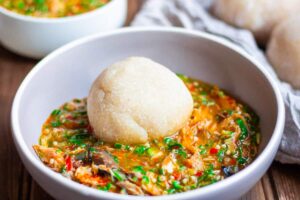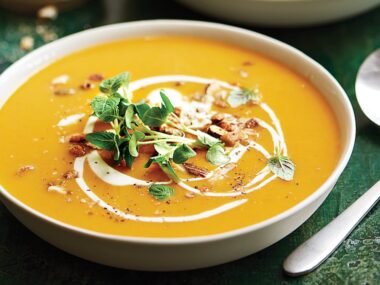Nigeria, a country known for its rich cultural diversity, boasts a culinary landscape as varied as its people. With over 250 ethnic groups, each region in Nigeria offers distinct flavors, ingredients, and cooking techniques, creating a mosaic of culinary traditions that reflect the nation’s cultural heritage. Understanding the regional differences in Nigerian cooking not only offers a culinary adventure but also a deeper appreciation of the country’s diverse cultural fabric.

Northern Nigeria: The Land of Rich Spices and Grains
Northern Nigerian cuisine is heavily influenced by the region’s arid climate and the agricultural practices of its predominantly Muslim population. The staple foods here are grains such as millet, sorghum, and maize, often used to make dishes like tuwo shinkafa (rice pudding) and tuwo masara (corn pudding).
One of the most notable dishes from the North is suya, a popular street food made from skewered, spicy grilled meat. The meat, typically beef, chicken, or ram, is marinated in a blend of ground peanuts, cayenne pepper, ginger, and other spices, then grilled to perfection. Another beloved dish is miyan kuka, a soup made from powdered baobab leaves, often served with rice or tuwo.
Spices play a crucial role in Northern Nigerian cuisine. Ingredients like ginger, cloves, and nutmeg are frequently used, giving the dishes a distinctive, aromatic flavor. Jollof rice, a popular dish throughout West Africa, has a unique northern twist with added spices and sometimes, local vegetables.
Southern Nigeria: A Bounty of Seafood and Tropical Ingredients
Southern Nigeria, encompassing regions like the Niger Delta, is characterized by its abundance of rivers and proximity to the Atlantic Ocean, making seafood a staple in the diet. The cuisine here is rich and diverse, with a heavy reliance on fresh fish, shrimp, and other seafood, combined with an array of tropical ingredients.
The Yoruba people of the Southwest are known for dishes such as eba (cassava dough) served with egusi soup, made from melon seeds, leafy vegetables, and a variety of meats or fish. Ayamase, also known as ofada stew, is another southwestern delicacy, made from green bell peppers and fermented locust beans, offering a spicy, umami-rich experience.
In the coastal regions, you’ll find pepper soup, a fiery broth made with fish or meat, flavored with local spices like uda pods and alligator pepper. This dish is often enjoyed as an appetizer or a comfort food. Another significant dish is banga soup, originating from the Niger Delta, made from palm nut extract and often cooked with fresh catfish or dried fish, giving it a unique, rich taste.
Eastern Nigeria: The Heart of Yam and Cassava
Eastern Nigeria, home to the Igbo people, features a cuisine centered around yams and cassava. These starchy staples are versatile and form the basis of many traditional dishes. Fufu, made from pounded yam, cassava, or plantains, is a common accompaniment to soups and stews.
One of the most famous dishes from this region is ofe nsala (white soup), made with catfish and thickened with yam. The soup is flavored with traditional spices like utazi leaves and ogiri (fermented oil seeds), providing a slightly bitter yet deeply savory flavor profile.
Ofe onugbu (bitter leaf soup) is another signature dish, featuring a blend of bitter leaves, assorted meats, and seasonings. This dish exemplifies the Igbo preference for complex, hearty soups that are both nutritious and flavorful. Abacha (African salad), made from shredded cassava, palm oil, and spices, is a popular snack or side dish, showcasing the region’s innovative use of cassava.
Western Nigeria: A Blend of Indigenous and Foreign Influences
Western Nigeria, largely inhabited by the Yoruba people, presents a cuisine that reflects both indigenous culinary practices and influences from interactions with Europeans and other cultures. The region’s food is known for its bold flavors and the use of various local ingredients.
A prominent dish is amala, made from yam flour, often served with ewedu soup (jute leaves soup) and gbegiri (bean soup), creating a combination known as abula. The Yoruba are also famous for their asaro (yam porridge), which includes yam cooked with tomatoes, peppers, onions, and palm oil, resulting in a comforting, flavorful dish.
The use of peppers is significant in Western Nigerian cuisine, leading to spicy dishes like ata rodo (pepper sauce) that accompany many meals. Akara, deep-fried bean cakes, are a popular street food and breakfast item, enjoyed with pap (fermented corn pudding) or bread.
Conclusion
The culinary traditions of Nigeria are as diverse as its people, with each region offering unique dishes that reflect its history, environment, and cultural influences. From the spice-rich dishes of the North to the seafood delicacies of the South, the yam-based meals of the East, and the bold flavors of the West, Nigerian cuisine is a testament to the country’s rich cultural heritage and its ability to blend tradition with innovation. Exploring these regional differences not only delights the palate but also offers a deeper understanding of Nigeria’s diverse cultural landscape.










